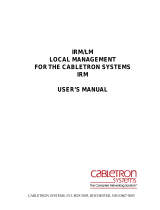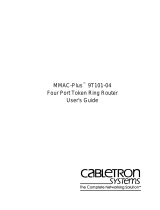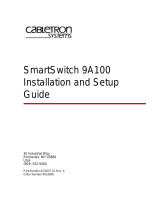Page is loading ...

MMAC-Plus
™
9E423-24
Ethernet SmartSwitch Module
User’s Guide

i
Notice
Notice
Cabletron Systems reserves the right to make changes in specifications and other information
contained in this document without prior notice. The reader should in all cases consult Cabletron
Systems to determine whether any such changes have been made.
The hardware, firmware, or software described in this manual is subject to change without notice.
IN NO EVENT SHALL CABLETRON SYSTEMS BE LIABLE FOR ANY INCIDENTAL, INDIRECT,
SPECIAL, OR CONSEQUENTIAL DAMAGES WHATSOEVER (INCLUDING BUT NOT LIMITED
TO LOST PROFITS) ARISING OUT OF OR RELATED TO THIS MANUAL OR THE INFORMATION
CONTAINED IN IT, EVEN IF CABLETRON SYSTEMS HAS BEEN ADVISED OF, KNOWN, OR
SHOULD HAVE KNOWN, THE POSSIBILITY OF SUCH DAMAGES.
© Copyright February 1996 by:
Cabletron Systems, Inc.
P.O. Box 5005
Rochester, NH 03867-0505
All Rights Reserved
Printed in the United States of America
Order Number: 9031668-01 February 1996
SPECTRUM
,
Remote LANVIEW
and
LANVIEW
are registered trademarks and
MMAC-Plus
is
a
trademark of Cabletron Systems, Inc.
Ethernet
is a trademark of Xerox Corporation.

ii
Notice
FCC Notice
This device complies with Part 15 of the FCC rules. Operation is subject to the following two
conditions: (1) this device may not cause harmful interference, and (2) this device must accept any
interference received, including interference that may cause undesired operation.
NOTE:
This equipment has been tested and found to comply with the limits for a Class A digital
device, pursuant to Part 15 of the FCC rules. These limits are designed to provide reasonable
protection against harmful interference when the equipment is operated in a commercial environment.
This equipment uses, generates, and can radiate radio frequency energy and if not installed in
accordance with the operator’s manual, may cause harmful interference to radio communications.
Operation of this equipment in a residential area is likely to cause interference in which case the user
will be required to correct the interference at his own expense.
WARNING:
Changes or modifications made to this device which are not expressly approved by the
party responsible for compliance could void the user’s authority to operate the equipment.
VCCI Notice
This equipment is in the 1st Class Category (information equipment to be used in commercial and/or
industrial areas) and conforms to the standards set by the Voluntary Control Council for Interference
by Information Technology Equipment (VCCI) aimed at preventing radio interference in commercial
and/or industrial areas.
Consequently, when used in a residential area or in an adjacent area thereto, radio interference may be
caused to radios and TV receivers, etc.
Read the instructions for correct handling.

iii
Notice
DOC Notice
This digital apparatus does not exceed the Class A limits for radio noise emissions from digital
apparatus set out in the Radio Interference Regulations of the Canadian Department of
Communications.
Le présent appareil numérique n’émet pas de bruits radioélectriques dépassant les limites applicables
aux appareils numériques de la class A prescrites dans le Règlement sur le brouillage radioélectrique
édicté par le ministère des Communications du Canada.

v
Contents
Chapter 1 Introduction
Features........................................................................................................................... 1-2
Related Manuals............................................................................................................ 1-5
Getting Help ..................................................................................................................1-5
Chapter 2 Installing the 9E423-24 Module
Unpacking the Module................................................................................................. 2-1
User Accessible Components ...................................................................................... 2-2
Setting the 9E423-24 Module DIP Switch.................................................................. 2-3
Installing the Module in the MMAC-Plus Chassis .................................................. 2-5
The Reset Switch ........................................................................................................... 2-7
Telco Connector............................................................................................................. 2-8
Chapter 3 Operation
ENIB................................................................................................................................ 3-2
SecureFast Switch.......................................................................................................... 3-2
i960 Core......................................................................................................................... 3-2
INB NIB .......................................................................................................................... 3-3
System Management Buses ......................................................................................... 3-3
SMB-1 Bus............................................................................................................... 3-3
SMB-10 Bus............................................................................................................. 3-3
System Diagnostic Controller...................................................................................... 3-4
DC/DC Converter ........................................................................................................ 3-4
INB Interface.................................................................................................................. 3-4
Chapter 4 LANVIEW LEDs
Chapter 5 Specifications
Technical Specifications................................................................................................ 5-1
CPU:......................................................................................................................... 5-1
Memory:.................................................................................................................. 5-1
Standards: ...............................................................................................................5-1
Network Interfaces: ............................................................................................... 5-1
Safety...............................................................................................................................5-2
Service............................................................................................................................. 5-2

Contents
vi
Physical...........................................................................................................................5-2
Dimensions: ............................................................................................................5-2
Weight:.....................................................................................................................5-2
Environment: ..........................................................................................................5-3

1-1
Chapter 1
Introduction
The 9E423-24 (Figure 1-1) is a 25 port switching module. Two RJ-71 Telco
connectors support 24 10BASE-T ports with the 25th port connecting to the
Internal Network Bus (INB) backplane interface. This module uses a SmartSwitch
ASIC design and an advanced Intel i960
®
microprocessor. This microprocessor
provides a platform for all management functions within a scalable RISC-Based
Architecture.
The module can operate in two modes; as a 24 port Ethernet traditional switch
(using 802.1d standards) with a high speed backbone connection or as a Secure
Fast Switch (SFS) with 24 Ethernet connections. Each port of the 9E423-24 can be
configured to operate in the Full Duplex mode. This configuration allows each
port to provide a full 20 Mbps of bandwidth for file servers or high end user
intensive work stations.
Network management information is available through a variety of methods. All
information based on Simple Network Management Protocol (SNMP) is
accessible either via an in-band (Front Panel port), Side Band (SMB-10), or via the
Environmental Module’s COM ports. Serial Line Internet Protocol (SLIP) or
Point-to-Point Protocol (PPP) are supported by the Environmental Module’s
COM ports. For more information on the SMB-10, SLIP or PPP refer to the
MMAC-Plus Local Management User’s Guide.
The 9E423-24 also features front panel LANVIEW™ Diagnostic LED’s to offer at-
a-glance status information about each front panel port as well as the operation of
the overall module.
Ethernet networks are connected to the 9E423-24 module through two standard
RJ-71 Telco connectors built in the front of the module. Each connector provides
12 Ethernet 10BASE-T connections for UTP and STP links up to 100 meters long.

Introduction
1-2
Features
Processor
The 9E423-24 is equipped with an advanced Intel i960 microprocessor. This
microprocessor provides a platform for all management functions such as
Spanning Tree, RMON, and MIB support within a scalable RISC-Based
architecture.
Fast Packet Switching
The 9E423-24 incorporates a hardware based switch design referred to as the
SmartSwitch ASIC, a collection of custom ASICs designed specifically for high
speed switching. Because all frame translation, address lookups, and forwarding
decisions are performed in hardware, the 9E423-24 can obtain a throughput
performance of greater than 750K pps.
Management
The 9E423-24 features SNMP for local and remote management. Local
management is provided through the RS-232 Com ports on the MMAC-Plus
Environmental Module using a standard VT-220 terminal or emulator. Remote
management is possible through Cabletron’s SPECTRUM or any SNMP
compliant management tool. Included as management features are the IETF
Standard Management Information Base (MIBs) RMON (RFC1271), IETF MIB II
(RFC-1213), IETF Bridge MIB (RFC-1493), and a host of other Cabletron enterprise
MIBs. The 9E423-24 also offers the user a wide variety of statistical network
management information to enhance network planning and troubleshooting. This
module provides information for each front panel Ethernet 10BASE-T port,
including packet counts along with errored frame information such as collisions,
CRCs, and Giants, via a variety of industry standard and private MIBS. Industry
standard IEEE 802.1d bridging, including Spanning Tree Algorithm, is supported.
Connectivity
The 9E423-24 module has one interface to the INB and two front panel RJ-71 Telco
connectors. The INB interface is a fixed connection to INB-2 which allows the
9E423-24 to communicate with other MMAC-Plus modules supporting various
LAN technologies including: Token Ring, FDDI, Ethernet, WAN and ATM. Each
front panel RJ-71 connectors provide 12 Ethernet 10BASE-T connections for UTP
and STP links up to 100 meters in length.
Standard Ethernet/Full Duplex Operation
The 9E423-24 Module supports 10BASE-T. The use of 10BASE-T allows each port
on the 9E423-24 Module to be configured, through local and or remote
management (SNMP), to operate in standard Ethernet mode (simplex) or full
duplex mode. Operating in standard Ethernet mode limits bandwidth to 10 Mbps
per port, while operating in duplex mode doubles bandwidth from 10 Mbps to 20
Mbps per port.

1-3
Features
Management Information Base (MIB) Support
The 9E423-24 provides MIB support including:
• RMON (RFC-1271)
• IETF MIB II (RFC-1213)
• IETF Bridge MIB (RFC-1493)
and a host of other Cabletron Enterprise MIBs.
INB
The 9E423-24 attaches to INB2 of the MMAC-Plus Backplane. The INB has a
capacity of 2 Gbps to interconnect MMAC-Plus modules supporting Ethernet,
FDDI, Token Ring, WAN and ATM networks. The INB transports fixed length
data blocks between modules in the MMAC-Plus hub using a Time Division
Multiplexing (TDM) design. Within the INB there is a 64 bit wide data bus and an
eight bit control management bus. Each module that attaches to the INB has an
INB Network Interface Block (NIB). The INB NIB converts canonical frames to
fixed length data blocks for transmission onto the INB. For data blocks received
from the INB, the INB NIB reassembles the data blocks received from the INB
back into canonical frames for transmission to the SmartSwitch ASIC and
ultimately to the front panel port. The INB can time slice its bandwidth using one
of three methods. The default method is standard TDM round-robin bandwidth
arbitration, the second method is for modules to reserve a specific amount of
bandwidth using MONARCH, Cabletron’s INB Bandwidth Arbitrator, the third
method permits the lowest slot number to use any bandwidth not used by the
previous two methods.
LANVIEW LEDs
The 9E423-24 uses LANVIEW – the Cabletron Systems built-in visual diagnostic
and status monitoring system. With LANVIEW LEDs, you can quickly identify, at
a glance, system status as well as the device, port, and physical layer status. Two
LEDs indicate the transmission and reception of data from the INB MMAC-Plus
backplane connection. Each of the 12 Ethernet front panel ports features two
LEDs per port to indicate the port’s Administrative status (enabled/disabled),
LINK status (Link/Nolink), and Data Activity (receiving and transmitting data).
For a complete list of supported MIBs, refer to the release notes provided in the
9E423-24 package.
NOTE

Introduction
1-4
Figure 1-1. The 9E423-24 Module
SMB CPU
INB
1
12
13
24
10
B
A
S
E
T
10
B
A
S
E
T
9E423-24
MAPLE

1-5
Related Manuals
Related Manuals
The manuals listed below should be used to supplement the procedures and
technical data contained in this manual.
MMAC-Plus Installation Guide
MMAC-Plus 9C300-1 Environmental Module User’s Guide
MMAC-Plus 9C214-1 AC Power Supply User’s Guide
MMAC-Plus Local Management User’s Guide
INB Terminator Modules Installation Guide
Getting Help
If you need additional support with the MMAC-Plus, or if you have any
questions, comments or suggestions concerning this manual, feel free to contact
Cabletron Systems Technical Support:
By phone: (603) 332-9400
By CompuServe®: GO CTRON from any ! prompt
By Internet mail: [email protected]
By Fax: (603) 337-3075
By BBS: (603) 335-3358
By mail: Cabletron Systems, Inc.
P.O. Box 5005
Rochester, NH 03867-0505

Introduction
1-6

2-1
Chapter 2
Installing the 9E423-24 Module
The 9E423-24 module occupies a single slot in the MMAC-Plus chassis.
Install the 9E423-24 module by following the steps starting below.
Unpacking the Module
1. Carefully remove the module from the shipping box. (Save the box and
packing materials in the event the module must be reshipped.)
2. Remove the module from the plastic bag. Observe all precautions to prevent
damage from Electrostatic Discharge (ESD).
3. Carefully examine the module, checking for damage. If any damage exists,
DO NOT install the module. Contact Cabletron Systems Technical Support
immediately.
The INB Terminator Modules must be installed on the rear of the chassis before powering
up this module. Refer to the INB Terminator Modules Installation Guide for
information and installation procedure.
NOTE

Installing the 9E423-24 Module
2-2
User Accessible Components
Figure 2-1 shows the various components that can be accessed by users. These
consist of an eight position dip switch (explained in the next section), replaceable
PROMs, and sockets for memory and flash upgrades. These will be used for
future upgrades. Instructions for installing the components will be supplied with
the upgrade kit.
Figure 2-1. User Accessible Components
int
e
l
i960
SMB1 Prom
DRAM
Flash Simm
Boot Prom
Stats Engine
Socket
Stats Engine
Jumper
Dip
Switch

2-3
Setting the 9E423-24 Module DIP Switch
Setting the 9E423-24 Module DIP Switch
The DIP switch on the 9E423-24 Module (Figure 2-1 and Figure 2-2), is an eight
switch DIP located near the bottom left corner of the module. Each switch is set
according to the functions described in Table 2-1.
If switch settings are changed, the processor on the module must be reset by using
the reset switch or repowering the module for the changes to take effect.
Figure 2-2. 9E423-24 Module DIP Switch location
1
2
3
4
5
6
7
8
int
e
l
i960

Installing the 9E423-24 Module
2-4
See the
Cautions
at the end of this table.
Table 2-1. Function of DIP Switch
Switch
Function Description
8
Clear
Password
-1
This module stores user entered passwords in
NVRAM (Nonvolatile random access memory). To
clear these passwords, toggle this switch and then
reset the module’s processor. Once the module resets,
factory default passwords are placed in NVRAM. You
can use these default passwords or, if desired, enter
new passwords. To enter new passwords, refer to the
Module Local Management User’s Guide.
7
Clear
NVRAM
-2
This module stores user entered parameters such as IP
addresses, subnet masks, default gateway, default
interface, SNMP traps, bridge configurations and
module specific configurations in NVRAM. To clear
these parameters toggle this switch and then reset the
module’s processor. Once the module resets, factory
default parameters are placed in NVRAM. You can
use the default parameters or, if desired, enter new
parameters. To enter new parameters, refer to the
Module Local Management User’s Guide.
6
Force
BOOTP
Download
This module uses BOOTP (Boot Strap Protocol) to
download new versions of the image file into Flash
Memory. This procedure forces image files to be
downloaded from the PC or Workstation, configured
to act as the BOOTP server, connected to the EPIM
port in the Environmental Module.
5 Reserved
For Factory Use Only
4 Reserved
For Factory Use Only
3 Reserved
For Factory Use Only
2 Reserved
For Factory Use Only
1 Reserved
For Factory Use Only
1. Caution: Do not toggle Switch 8 unless you intend to reset the user
configured passwords to the factory default settings.
2. Caution: Do not toggle Switch 7 unless you intend to reset the user entered
parameters to the factory default settings.
!
CAUTION

2-5
Installing the Module in the MMAC-Plus Chassis
Installing the Module in the MMAC-Plus Chassis
To install the 9E423-24 Module, in the MMAC-Plus Chassis, follow the steps
below:
1. Remove the blank panel, covering the slot in which the module will be
mounted. All other slots must be covered to ensure proper airflow and
cooling.
2. Attach one end of the ESD wrist strap packaged with the MMAC-Plus chassis
to your wrist. Plug the other end into the jack for the ESD Wrist Strap in the
lower right corner of the MMAC-Plus Chassis shown in Figure 2-3.
3. Install the module in the chassis by sliding it into slots and locking down both
the top and bottom plastic tabs, as shown in Figure 2-3. Take care that the
module is between the card guides as shown, it slides in straight, and engages
the backplane connectors properly.

Installing the 9E423-24 Module
2-6
Warning:
Ensure that the circuit card is between the card guides.
Lock down the top and bottom plastic tabs
at the same time
, applying even pressure.
Figure 2-3. Installing the 9E423-24 Module
J
7
FLNK
8
FLNK
FLNK
10
FLNK
INS
11
FLNK
INS
12
RX
TX
RX
TX
RX
Metal Back-Panel
Circuit Card
Card Guides
Jack for ESD
wrist strap

2-7
The Reset Switch
The Reset Switch
The Reset switch is located on the front panel, under the top plastic tab as shown
in Figure 2-4. It serves three functions: resetting the i960 processor, shutting down
the module, or restarting the module.
• To reset the i960 processor, press the reset switch twice within three seconds.
• To shut down the module, press and hold the reset switch down for three or
more seconds.
• To restart the module after it has been shut down, press and release the Reset
Switch.
For security, SNMP management can be used to disable the functions of this
switch.
Figure 2-4. The Reset Switch
Reset Switch

Installing the 9E423-24 Module
2-8
Telco Connector
The 9E423-24 front panel has two RJ-71 Telco connectors each supporting 12
10BASE-T ports. Figure 2-5 illustrates an RJ-71 Telco Connector.
Figure 2-5. RJ-71 Telco Connector
Table 2-2 details the pinout connections for an RJ-71 Telco connector.
Table 2-2. Pinout Connections RJ-71 Telco Connector
Pin
Signal Wire Color Pin Signal Wire Color
1 RX 1- Blue/White 26 RX 1+ White/Blue
2 TX 1- Orange/White 27 TX 1+ White/Orange
3 RX 2- Green/White 28 RX 2+ White/Green
4 TX 2- Brown/White 29 TX 2+ White/Brown
5 RX 3- Gray/White 30 RX 3+ White/Gray
6 TX 3- Blue/Red 31 TX 3+ Red/Blue
7 RX 4- Orange/Red 32 RX 4+ Red/Orange
8 TX 4- Green/Red 33 TX 4+ Red/Green
9 RX 5- Brown/Red 34 RX 5+ Red/Brown
10 TX 5- Gray/Red 35 TX 5+ Red/Gray
11 RX 6- Blue/Black 36 RX 6+ Black/Blue
12 TX 6- Orange/Black 37 TX 6+ Black/Orange
13 RX 7- Green/Black 38 RX 7+ Black/Green
14 TX 7- Brown/Black 39 TX 7+ Black/Brown
15 RX 8- Gray/Black 40 RX 8+ Black/Gray
/












